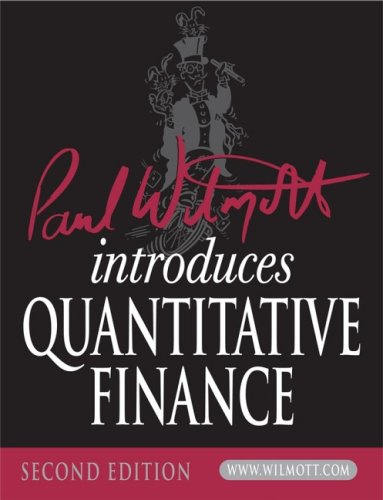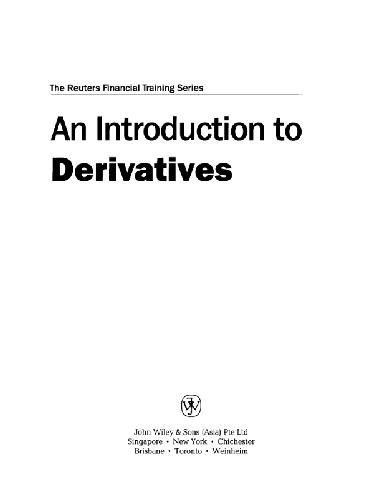Paul Wilmott9780470319581, 9780470512869, 0470319585
Table of contents :
Paul Wilmott Introduces Quantitative Finance……Page 4
Contents……Page 10
Preface……Page 26
1 Products and Markets: Equities, Commodities, Exchange Rates, Forwards and Futures……Page 30
1.2 Equities……Page 31
1.2.1 Dividends……Page 36
1.2.2 Stock splits……Page 37
1.4 Currencies……Page 38
1.6 The time value of money……Page 40
1.8 Inflation-proof bonds……Page 46
1.9 Forwards and futures……Page 48
1.9.1 A first example of no arbitrage……Page 49
1.10 More about futures……Page 51
1.10.2 FX futures……Page 52
1.11 Summary……Page 53
2 Derivatives……Page 56
2.2 Options……Page 57
2.3 Definition of common terms……Page 62
2.4.1 Other representations of value……Page 63
2.7 Market conventions……Page 68
2.8 The value of the option before expiry……Page 69
2.9 Factors affecting derivative prices……Page 70
2.10 Speculation and gearing……Page 71
2.12 Put-call parity……Page 73
2.13 Binaries or digitals……Page 76
2.14 Bull and bear spreads……Page 77
2.15 Straddles and strangles……Page 79
2.16 Risk reversal……Page 81
2.18 Calendar spreads……Page 82
2.21 Convertible bonds……Page 84
2.22 Over the counter options……Page 85
2.23 Summary……Page 86
3 The Binomial Model……Page 88
3.1 Introduction……Page 89
3.2 Equities can go down as well as up……Page 90
3.3 The option value……Page 92
3.5 Why should this ‘theoretical price’ be the ‘market price’?……Page 94
3.6 How did I know to sell 12 of the stock for hedging?……Page 95
3.7 How does this change if interest rates are non-zero?……Page 96
3.8 Is the stock itself correctly priced?……Page 97
3.10 The real and risk-neutral worlds……Page 98
3.10.1 Non-zero interest rates……Page 101
3.11 And now using symbols……Page 102
3.11.2 Standard deviation of asset price change……Page 103
3.12.1 Hedging……Page 104
3.12.2 No arbitrage……Page 105
3.14 Counter-intuitive?……Page 106
3.16 The asset price distribution……Page 107
3.17 Valuing back down the tree……Page 109
3.18 Programming the binomial method……Page 114
3.19 The greeks……Page 115
3.20 Early exercise……Page 117
3.22 Summary……Page 119
4 The Random Behavior of Assets……Page 124
4.2 The popular forms of ‘analysis’……Page 125
4.3 Why we need a model for randomness: Jensen’s inequality……Page 126
4.4 Similarities between equities, currencies, commodities and indices……Page 128
4.5 Examining returns……Page 129
4.6 Timescales……Page 134
4.6.1 The drift……Page 136
4.6.2 The volatility……Page 137
4.8 The random walk on a spreadsheet……Page 138
4.9 The Wiener process……Page 140
4.10 The widely accepted model for equities, currencies, commodities and indices……Page 141
4.11 Summary……Page 144
5 Elementary Stochastic Calculus……Page 146
5.2 A motivating example……Page 147
5.5 Quadratic variation……Page 149
5.6 Brownian motion……Page 150
5.7 Stochastic integration……Page 151
5.8 Stochastic differential equations……Page 152
5.10 Functions of stochastic variables and Itô’s lemma……Page 153
5.12 Itô and Taylor……Page 156
5.14 Some pertinent examples……Page 159
5.14.1 Brownian motion with drift……Page 160
5.14.2 The lognormal random walk……Page 161
5.14.3 A mean-reverting random walk……Page 163
5.14.4 And another mean-reverting random walk……Page 164
5.15 Summary……Page 165
6 The Black–Scholes Model……Page 168
6.2 A very special portfolio……Page 169
6.4 No arbitrage……Page 171
6.5 The Black–Scholes equation……Page 172
6.6 The Black–Scholes assumptions……Page 174
6.7 Final conditions……Page 175
6.9 Currency options……Page 176
6.11 Expectations and Black–Scholes……Page 177
6.12.3 CAPM/utility……Page 178
6.13 No arbitrage in the binomial, Black–Scholes and ‘other’ worlds……Page 179
6.14.1 Forward contracts……Page 180
6.15 Futures contracts……Page 181
6.17 Summary……Page 182
7 Partial Differential Equations……Page 186
7.2 Putting the Black–Scholes equation into historical perspective……Page 187
7.4 Boundary and initial/final conditions……Page 188
7.5.1 Transformation to constant coefficient diffusion equation……Page 189
7.5.3 Series solution……Page 190
7.7 Other analytical techniques……Page 192
7.9 Summary……Page 193
8 The Black–Scholes Formulæ and the ‘Greeks’……Page 198
8.2 Derivation of the formulæ for calls, puts and simple digitals……Page 199
8.2.1 Formula for a call……Page 204
8.2.2 Formula for a put……Page 208
8.2.3 Formula for a binary call……Page 210
8.3 Delta……Page 211
8.4 Gamma……Page 213
8.6 Speed……Page 216
8.7 Vega……Page 217
8.8 Rho……Page 219
8.9 Implied volatility……Page 220
8.10.2 The two main classifications……Page 223
8.10.6 Static hedging……Page 224
8.11 Summary……Page 225
9 Overview of Volatility Modeling……Page 232
9.2.2 Historical or realized volatility……Page 233
9.3.1 The simplest volatility estimate: constant volatility/moving window……Page 234
9.3.3 Exponentially weighted moving average……Page 235
9.3.5 Expected future volatility……Page 236
9.3.6 Beyond close-close estimators: range-based estimation of volatility……Page 238
9.4.2 Three hats……Page 240
9.4.3 The math behind this: find the standard deviation……Page 242
9.4.4 Quants’ salaries……Page 243
9.5 Skews and smiles……Page 244
9.5.2 Sensitivity of the risk reversal to skews and smiles……Page 245
9.6.1 To calibrate or not?……Page 246
9.6.2 Deterministic volatility surfaces……Page 247
9.6.4 Uncertain parameters……Page 248
9.6.7 Asymptotic analysis of volatility……Page 249
9.8 Summary……Page 250
10 How to Delta Hedge……Page 254
10.1 Introduction……Page 255
10.2 What if implied and actual volatilities are different?……Page 256
10.4 Case 1: Hedge with actual volatility, σ……Page 257
10.5 Case 2: Hedge with implied volatility, σ……Page 260
10.5.1 The expected profit after hedging using implied volatility……Page 261
10.5.2 The variance of profit after hedging using implied volatility……Page 262
10.6 Hedging with different volatilities……Page 264
10.6.2 Actual volatility > Implied volatility……Page 265
10.7.1 Hedging with actual volatility……Page 267
10.8 Portfolios when hedging with implied volatility……Page 268
10.8.2 Variance……Page 269
10.9 How does implied volatility behave?……Page 270
10.9.2 Sticky delta……Page 271
10.9.3 Time-periodic behavior……Page 272
10.10 Summary……Page 274
11 An Introduction to Exotic and Path-dependent Options……Page 276
11.2 Option classification……Page 277
11.3 Time dependence……Page 278
11.4 Cashflows……Page 279
11.5.1 Strong path dependence……Page 281
11.5.2 Weak path dependence……Page 282
11.6 Dimensionality……Page 283
11.7 The order of an option……Page 284
11.8 Embedded decisions……Page 285
11.10.1 Compounds and choosers……Page 287
11.10.2 Range notes……Page 291
11.10.3 Barrier options……Page 293
11.10.5 Lookback options……Page 294
11.11 Summary of math/coding consequences……Page 295
11.12 Summary……Page 296
12 Multi-asset Options……Page 300
12.2 Multidimensional lognormal random walks……Page 301
12.3 Measuring correlations……Page 303
12.4 Options on many underlyings……Page 306
12.6 Exchanging one asset for another: a similarity solution……Page 307
12.7 Two examples……Page 309
12.8 Realities of pricing basket options……Page 311
12.10 Correlation versus cointegration……Page 312
12.11 Summary……Page 313
13 Barrier Options……Page 316
13.2 Different types of barrier options……Page 317
13.3.1 Monte Carlo simulation……Page 318
13.4 Pricing barriers in the partial differential equation framework……Page 319
13.4.1 ‘Out’ barriers……Page 320
13.4.2 ‘In’ barriers……Page 321
13.5 Examples……Page 322
13.5.1 Some more examples……Page 323
13.6.1 Early exercise……Page 329
13.6.6 Parisian options……Page 330
13.7 Market practice: what volatility should I use?……Page 331
13.8 Hedging barrier options……Page 334
13.8.1 Slippage costs……Page 335
13.9 Summary……Page 336
14 Fixed-income Products and Analysis: Yield, Duration and Convexity……Page 348
14.2.1 The zero-coupon bond……Page 349
14.2.3 The money market account……Page 350
14.2.4 Floating rate bonds……Page 351
14.2.6 Repos……Page 352
14.3.1 United States of America……Page 353
14.5 Day-count conventions……Page 354
14.6 Continuously and discretely compounded interest……Page 355
14.7.2 The yield to maturity (YTM) or internal rate of return (IRR)……Page 356
14.9 Price/yield relationship……Page 358
14.10 Duration……Page 360
14.11 Convexity……Page 362
14.13 Hedging……Page 364
14.14 Time-dependent interest rate……Page 367
14.16 Forward rates and bootstrapping……Page 368
14.16.1 Discrete data……Page 369
14.16.2 On a spreadsheet……Page 371
14.17 Interpolation……Page 373
14.18 Summary……Page 375
15 Swaps……Page 378
15.2 The vanilla interest rate swap……Page 379
15.3 Comparative advantage……Page 380
15.4 The swap curve……Page 382
15.5 Relationship between swaps and bonds……Page 383
15.6 Bootstrapping……Page 384
15.7 Other features of swaps contracts……Page 385
15.8.3 Currency swaps……Page 386
15.9 Summary……Page 387
16 One-factor Interest Rate Modeling……Page 388
16.1 Introduction……Page 389
16.2 Stochastic interest rates……Page 390
16.3 The bond pricing equation for the general model……Page 391
16.4 What is the market price of risk?……Page 394
16.6.1 Vasicek……Page 395
16.6.2 Cox, Ingersoll & Ross……Page 396
16.6.3 Ho & Lee……Page 397
16.7.1 Forward contracts……Page 398
16.8 Futures contracts……Page 399
16.8.1 The convexity adjustment……Page 400
16.9 Summary……Page 401
17 Yield Curve Fitting……Page 402
17.2 Ho & Lee……Page 403
17.3 The extended Vasicek model of Hull & White……Page 404
17.4.2 Against……Page 405
17.6 Summary……Page 409
18 Interest Rate Derivatives……Page 412
18.2 Callable bonds……Page 413
18.3 Bond options……Page 414
18.3.1 Market practice……Page 416
18.4.1 Cap/floor parity……Page 418
18.4.4 Collars……Page 420
18.6.1 Market practice……Page 421
18.8 Index amortizing rate swaps……Page 423
18.8.1 Other features in the index amortizing rate swap……Page 425
18.9 Contracts with embedded decisions……Page 426
18.10 Some examples……Page 427
18.11 More interest rate derivatives. . …….Page 429
18.12 Summary……Page 430
19 The Heath, Jarrow & Morton and Brace, Gatarek & Musiela Models……Page 432
19.3 The spot rate process……Page 433
19.4 The market price of risk……Page 435
19.5.1 The relationship between the risk-neutral forward rate drift and volatility……Page 436
19.7 Simulations……Page 437
19.8 Trees……Page 439
19.11 Spreadsheet implementation……Page 440
19.12 A simple one-factor example: Ho & Lee……Page 441
19.13 Principal Component Analysis……Page 442
19.13.1 The power method……Page 444
19.15 Non-infinitesimal short rate……Page 445
19.16 The Brace, Gatarek & Musiela model……Page 446
19.18 PVing the cashflows……Page 448
19.19 Summary……Page 449
20 Investment Lessons from Blackjack and Gambling……Page 452
20.2 The rules of blackjack……Page 453
20.3 Beating the dealer……Page 455
20.3.1 Summary of winning at blackjack……Page 456
20.4 The distribution of profit in blackjack……Page 457
20.5 The Kelly criterion……Page 458
20.6 Can you win at roulette?……Page 461
20.7.1 Setting the odds in a sporting game……Page 462
20.8 Arbitrage……Page 463
20.9 How to bet……Page 465
20.10 Summary……Page 467
21 Portfolio Management……Page 470
21.2 Diversification……Page 471
21.2.1 Uncorrelated assets……Page 472
21.3 Modern portfolio theory……Page 474
21.4 Where do I want to be on the efficient frontier?……Page 476
21.5 Markowitz in practice……Page 479
21.6.1 The single-index model……Page 480
21.6.2 Choosing the optimal portfolio……Page 482
21.8 Cointegration……Page 483
21.9 Performance measurement……Page 484
21.10 Summary……Page 485
22 Value at Risk……Page 488
22.2 Definition of Value at Risk……Page 489
22.3 VaR for a single asset……Page 490
22.4 VaR for a portfolio……Page 492
22.5.2 The delta/gamma approximation……Page 493
22.6 Simulations……Page 495
22.6.2 Bootstrapping……Page 496
22.7 Use of VaR as a performance measure……Page 497
22.8.1 Some EVT results……Page 498
22.10 Summary……Page 499
23 Credit Risk……Page 502
23.2 The Merton model: equity as an option on a company’s assets……Page 503
23.3 Risky bonds……Page 504
23.4 Modeling the risk of default……Page 505
23.5 The Poisson process and the instantaneous risk of default……Page 506
23.6 Time-dependent intensity and the term structure of default……Page 510
23.7 Stochastic risk of default……Page 511
23.8 Positive recovery……Page 513
23.9 Hedging the default……Page 514
23.10 Credit rating……Page 515
23.12 Copulas: pricing credit derivatives with many underlyings……Page 517
23.12.2 The mathematical definition……Page 518
23.13 Collateralized debt obligations……Page 519
23.14 Summary……Page 521
24 RiskMetrics and CreditMetrics……Page 524
24.3 Calculating the parameters the RiskMetrics way……Page 525
24.3.1 Estimating volatility……Page 526
24.4 The CreditMetrics dataset……Page 527
24.4.1 Yield curves……Page 528
24.4.4 Correlations……Page 529
24.6 A portfolio of risky bonds……Page 530
24.8 Summary……Page 531
25 CrashMetrics……Page 534
25.3 Market crashes……Page 535
25.4 CrashMetrics……Page 536
25.5 CrashMetrics for one stock……Page 537
25.6 Portfolio optimization and the Platinum hedge……Page 539
25.7 The multi-asset/single-index model……Page 540
25.7.1 Assuming Taylor series for the moment……Page 546
25.8 Portfolio optimization and the Platinum hedge in the multi-asset model……Page 548
25.9 The multi-index model……Page 549
25.10 Incorporating time value……Page 550
25.11.2 Modeling margin……Page 551
25.13 Simple extensions to CrashMetrics……Page 553
25.14 The CrashMetrics Index (CMI)……Page 554
25.15 Summary……Page 555
26 Derivatives **** Ups……Page 556
26.2 Orange County……Page 557
26.3 Proctor and Gamble……Page 558
26.4 Metallgesellschaft……Page 561
26.5 Gibson Greetings……Page 562
26.6 Barings……Page 565
26.7 Long-Term Capital Management……Page 566
26.8 Summary……Page 569
27 Overview of Numerical Methods……Page 570
27.2 Finite-difference methods……Page 571
27.2.2 Program of study……Page 572
27.3 Monte Carlo methods……Page 573
27.3.2 Program of study……Page 574
27.4.2 Program of study……Page 575
27.5 Summary……Page 576
28 Finite-difference Methods for One-factor Models……Page 578
28.2 Grids……Page 579
28.4 Approximating θ……Page 582
28.5 Approximating Δ……Page 583
28.7 Example……Page 586
28.8 Bilinear interpolation……Page 587
28.9 Final conditions and payoffs……Page 588
28.10 Boundary conditions……Page 589
28.11 The explicit finite-difference method……Page 591
28.11.2 Convergence of the explicit method……Page 594
28.12 The Code #1: European option……Page 596
28.13 The Code #2: American exercise……Page 600
28.14 The Code #3: 2-D output……Page 602
28.15 Upwind differencing……Page 604
28.16 Summary……Page 607
29 Monte Carlo Simulation……Page 610
29.2 Relationship between derivative values and simulations: equities, indices, currencies, commodities……Page 611
29.3 Generating paths……Page 612
29.4 Lognormal underlying, no path dependency……Page 613
29.5 Advantages of Monte Carlo simulation……Page 614
29.6 Using random numbers……Page 615
29.7.1 Box–Muller……Page 616
29.8 Real versus risk neutral, speculation versus hedging……Page 617
29.9 Interest rate products……Page 619
29.10 Calculating the greeks……Page 622
29.11 Higher dimensions: Cholesky factorization……Page 623
29.13 Speeding up convergence……Page 625
29.13.2 Control variate technique……Page 626
29.15 American options……Page 627
29.16 Longstaff & Schwartz regression approach for American options……Page 628
29.18 Summary……Page 632
30 Numerical Integration……Page 634
30.2 Regular grid……Page 635
30.3 Basic Monte Carlo integration……Page 636
30.4 Low-discrepancy sequences……Page 638
30.5 Advanced techniques……Page 642
30.6 Summary……Page 643
A All the Math You Need… and No More (An Executive Summary)……Page 646
A.3 log……Page 647
A.4 Differentiation and Taylor series……Page 649
A.6 Mean, standard deviation and distributions……Page 652
A.7 Summary……Page 655
B Forecasting the Markets? A Small Digression……Page 656
B.2.2 Support and resistance……Page 657
B.2.4 Moving averages……Page 658
B.2.7 Bollinger bands……Page 661
B.2.8 Miscellaneous patterns……Page 662
B.2.10 Point and figure charts……Page 664
B.3 Wave theory……Page 666
B.4 Other analytics……Page 667
B.5.1 Effect of demand on price……Page 669
B.7 Summary……Page 670
C.4 Rules of the game……Page 672
C.5 Notes……Page 673
C.6.2 At the end of the game……Page 674
D Contents of CD accompanying Paul Wilmott Introduces Quantitative Finance, second edition……Page 678
E What you get if (when) you upgrade to PWOQF2……Page 682
Bibliography……Page 688
Index……Page 712







Reviews
There are no reviews yet.